Will Pfeifer's Blog, page 37
October 17, 2012
Great Moments in Comics History, Part 4
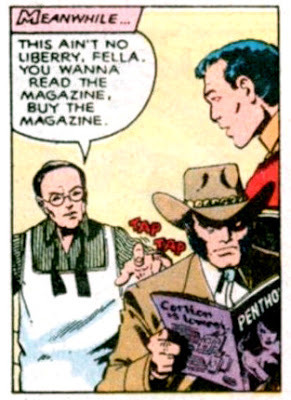
Wolverine gets busted reading a copy of Penthouse.
The Uncanny X-Men #129, Jan. 1980, plot by Chris Claremont and John Byrne, script by Chris Claremont, pencils by John Byrne, inks by Terry Austin, colors by Bob Sharen, letters by Tom Orzechowski.
Published on October 17, 2012 18:17
October 13, 2012
A dozen years after the fact, here at long last are my top films of the 1990s
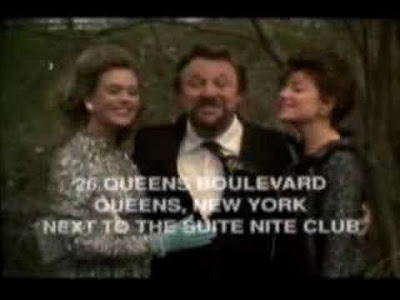
This week, The troublemakers over at the Onion AV Club spurred endless Internet arguments by listing their picks for the top 50 movies of the 1990s (found here, here and here). But, so you don't click over to there and forget all about this post, here are their picks for the top 10:
1. "Goodfellas"
2. "Pulp Fiction"
3. "Toy Story 2"
4. "Dazed and Confused"
5. "Chungking Express"
6. "Out of Sight"
7. "Reservoir Dogs"
8. "Unforgiven"
9. "Rushmore
10. "Being John Malkovich"
A respectable list by any measure, I'd say. Now, here's the list I compiled back in Dec. 1999 for my late, lamented Movie Man column in the Rockford Register Star:
1. "Goodfellas"
2. "Fight Club"
3. "Rushmore"
4, "Sling Blade"
5. "Schindler's List"
6. "Pulp Fiction"
7. "Boogie Nights"
8. "The Matrix"
9. "Toy Story"
10. "JFK"
Again, pretty respectable -- but one I'd make several changes to.
First of all. a few movies are coming off the list right away: "Schindler's List," "Sling Blade" and "Toy Story." "Toy Story" is great and hugely influential (which is why it made the list in the first place), but it's not nearly as good as 1999's "Toy Story 2" (to say nothing of "Toy Story 3.") "Sling Blade" is a wonderfully evocative film and introduced the world to Billy Bob Thornton, but it's really not Top 10 of the decade material (though I'd argue it's sadly forgotten -- it didn't even make the Onion's Top 50 list). And, upon further review, "Schindler's List" isn't really that great. It has some great moments, and the black-and-white cinematography is beautiful, but I think it got big critical points back in 1993 for being the movie where Steven Spielberg finally took on a serious topic -- in fact, he took on The Serious Topic. But, like many other movies when Spielberg gets serious (all of "The Color Purple," big chunks of "Saving Private Ryan," big chunks of "Munich" -- including that embarrassing third act), he couldn't quite stick the landing. The much-praised scene in "Schindler's List" where the girl's jacket is tinted red looks obvious and trite, and the ending -- where the formerly calm, cool and collected Schindler is reduced to hysterical tears -- never made sense and, frankly, smelled like an Oscar grab. So, to sum up, it's off the list. (Get it?)
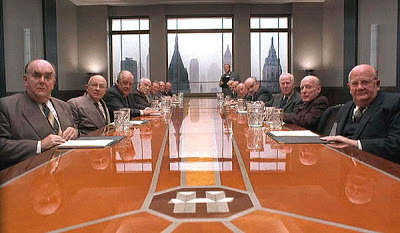
Which means we've got a few spots to fill. First things first, I'm correcting a shocking oversight and adding some Coen Brothers to the list. Joel and Ethan had a remarkable decade, with "Fargo," "Miller's Crossing" and "Barton Fink" all easily deserving places on the list. But I'm going with a personal favorite, arguably my favorite movie of all time, 1994's "The Hudsucker Proxy." It doesn't get a lot of love -- even from Coen fans -- but I could watch it every day until I die and not get bored. It's beautiful, it's funny and, I'd argue, damned near perfect. Where's the extras-laden Blu-ray of this one? (I'm looking at you, Criterion!)
For the remaining spots, I'm sticking in Chris Smith's documentary "American Movie" and Tim Burton's Hollywood biopic "Ed Wood." Both great movies about movies, and both hold up to this day. There. That's 10.
As for the other movies on my list, I feel a bit of defense might be in order. "Goodfellas," "Pulp Fiction" and "Rushmore" are clearly beyond reproach, and I'd argue that even though Fincher's "Fight Club" was very much a movie of its time, it's still a bracing black comedy with some brilliant direction and three strong central performances (Norton, Pitt and Bonham Carter). The reputation of "The Matrix" was forever tarnished by its lame sequels, but watch it again -- it's still one of the most exciting science fiction movies in decades, and those fight scenes may have inspired a thousand awful ripoffs, but they're still pretty thrilling. And damn, it all looks so good. So it stays.
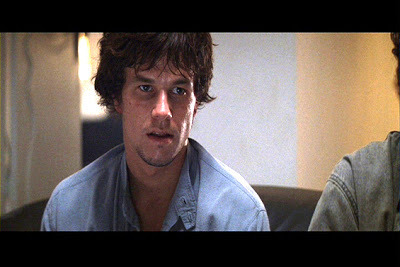
Compared with his Paul Thomas Anderson's last two films, "There Will Be Blood" and "The Master," 1997's "Boogie Nights" looks like the work of a young man indeed -- but that's one reason (of many) that I love it so much. Clearly, P.T.A. was trying everything he could, from split screens to jump cuts to loooooooong takes, and it makes the movie a whirlwind to watch. Any film that contains (a) those pitch-perfect porno spoofs, (b) that entire New Year's Eve sequence and (c) that shot of Dirk Diggler's face as "Jessie's Girl" plays deserves a spot on a Top 10 list. And believe me, Anderson's 1999 emotional epic "Magnolia" almost nabbed a spot, too.
Finally, I know Oliver Stone (somewhat deservedly) takes a hit from film fans, but I think that, at his best, he's one of the most interesting filmmakers around. Admittedly, the guy is rarely at his best, but he was in the 1990s, and though the theories espoused may be crazy, "JFK" is a hell of a visual experience. So is "Nixon," for that matter, I just missed putting that 1995 film on this list. (I loved "Natural Born Killers" back when it splattered across screens in 1994, but it has not aged well ... though that sitcom spoof with Rodney Dangerfield is still one of the creepiest things I've ever seen.)
Speaking of just-misseds, here are the also rans. If I, like the Onion, were doing a list of 50 great films of the 1990s, these would be on it: "Babe: Pig in the City," "Barton Fink," "Bound," "Bulworth," "Crumb," "Dazed and Confused," "Donnie Brasco," "Election," "Eyes Wide Shut," "Fargo," "Galaxy Quest," "The Game," "Gattaca," "Glengarry Glen Ross," "The Grifters," "Grosse Pointe Blank," "Groundhog Day," "Hearts of Darkness: A Filmmaker's Apocalypse," "Heavenly Creatures," "Homicide," "Hoop Dreams," "Iron Giant," "Kingpin," "L.A. Confidential," "The Limey," "Metropolitan," "Miami Blues," "Miller's Crossing," "Nixon," "Office Space," "Out of Sight," "A Perfect World," "Remains of the Day," "Reservoir Dogs," "Seven," "Silence of the Lambs," "South Park: Bigger, Longer and Uncut," "The Spanish Prisoner," "Starship Troopers," "Swingers," "Three Kings," "Trainspotting," "The Truman Show," "Twelve Monkeys," "Unforgiven," "The Usual Suspects," "Wag the Dog," "Waiting for Guffman," "Wayne's World" and, of course, "Zero Effect."
So I hope that settles everything ... unless, of course, you disagree? After all, a certain movie about a boat, a certain movie about dinosaurs, an Oscar-winning Western, a beloved prison drama and a fable about a simpleton and some chocolates weren't even mentioned.
Published on October 13, 2012 16:00
October 9, 2012
Great Moments in Comics History, Part 3
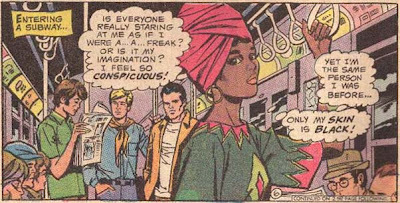
Lois Lane experiences racism. Maybe.
Superman's Girl Friend Lois Lane #106, Nov. 1970, script by Robert Kanigher, pencils by Werner Roth, inks by Vince Colletta.
Published on October 09, 2012 05:03
October 4, 2012
From the Bookshelves: 'Pranks!'
Fifth in a series of random, rambling explorations of my library.
Back in the days before the Internet, anyone craving to learn about fringe culture (like, say, yours truly) had to track down actual books from offbeat companies like Feral House, Loompanics and, in this case, RE/Search, a publisher founded by Andrea Juno and V.Vale and based (where else?) in San Francisco. RE/Search was responsible for memorable volumes devoted to William Burroughs, J.G. Ballard, "Modern Primitives," zine culture, "Incredibly Strange Music" (two great books) and, of course, "Incredibly Strange Films" (a true classic that I'll cover in this spot eventually).
But for me, the single volume that summed up what RE/Search was all about -- and exposed me to more fringe culture than I suspected existed -- was this 1987 book devoted to "Pranks!"
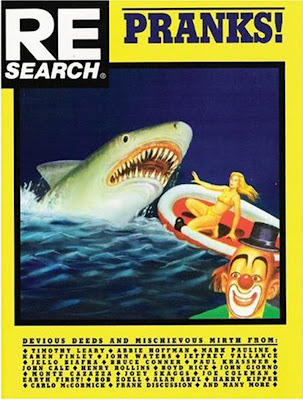
As you might have guessed by the somewhat disturbing cover, this is not a book about whoopie cushions, fake snot and flies in ice cubes. No, it's much more ambitious than that, devoting its 230-plus pages to all manner of cultural pranks, ranging from the innocently absurd (Jeffrey Vallance buys a frozen hen, then has it buried in a pet cemetery, complete with coffin and headstone) to the ominous and probably illegal (Boyd Rice describes trying to present a skinned sheep's head to former First Lady Betty Ford). Needless to say, to a goofball college student like myself, this was pretty crazy -- and crazily entertaining -- stuff. I didn't know how much was genuine and how much was bullshit, but it hardly made any difference. In this book, it was the stories themselves that mattered.
And believe me, there were some great stories. Ed Hardy (yes, that Ed Hardy) described a visit to Tokyo's Tattoo Museum, where actual human skin is on display, preserving the impressive works of tattoo art after their owners have gone to their graves, minus those surprisingly large patches of skin (and yes, Ed brought back photos). Mark Pauline shared tales of billboard vandalism (again, with photos) then segued into his claim to fame, the Survival Research Laboratories group, where giant machines battled it out, sometimes controlled by actual guinea pigs. And, most memorable of all, artist Joe Coleman told the story of how he attended a high school reunion (pretending to be a student who died years earlier) and, after mingling with the increasingly nervous crowd, took of his shirt and set off the explosives he had strapped to his chest. Sure, it sounds hard to believe, but the many photos included in the book confirm Coleman's outlandish tale.
And that's only scratching the surface. "Pranks" also features interviews (many surprisingly extensive -- the type is small!) with John Waters, Jello Biafra, Paul Krassner, Timothy Leary, Abbie Hoffman, Richard Meltzer, Paul Mavrides, Alan Abel and many more. Some are more entertaining than others, of course, but just about everyone in the book has at least one fascinating, funny or just plain strange tale to tell. As a bonus, there are several pages of suitably offbeat quotations (sample: "A chained man need only shut his eyes to make the world explode." -- Octavio Paz) and an amazing newspaper clipping on the last page describing a prank phone call that resulted in a house being demolished.
"Pranks" is still easy to find, and there was even a sequel released a couple of years ago with some of the same folks interviewed. And sure, a lot of these people -- and a lot of these stories -- can be found somewhere in the deep, dark corners of the Internet. But really, when you're reading about some guy blowing himself up at a high school reunion or another guy spending a fortune to bury a frozen chicken, wouldn't you rather read about it in an honest-to-god book? It makes the whole affair seem that much more respectable.
And hell, that's a pretty good prank all by itself.

Back in the days before the Internet, anyone craving to learn about fringe culture (like, say, yours truly) had to track down actual books from offbeat companies like Feral House, Loompanics and, in this case, RE/Search, a publisher founded by Andrea Juno and V.Vale and based (where else?) in San Francisco. RE/Search was responsible for memorable volumes devoted to William Burroughs, J.G. Ballard, "Modern Primitives," zine culture, "Incredibly Strange Music" (two great books) and, of course, "Incredibly Strange Films" (a true classic that I'll cover in this spot eventually).
But for me, the single volume that summed up what RE/Search was all about -- and exposed me to more fringe culture than I suspected existed -- was this 1987 book devoted to "Pranks!"

As you might have guessed by the somewhat disturbing cover, this is not a book about whoopie cushions, fake snot and flies in ice cubes. No, it's much more ambitious than that, devoting its 230-plus pages to all manner of cultural pranks, ranging from the innocently absurd (Jeffrey Vallance buys a frozen hen, then has it buried in a pet cemetery, complete with coffin and headstone) to the ominous and probably illegal (Boyd Rice describes trying to present a skinned sheep's head to former First Lady Betty Ford). Needless to say, to a goofball college student like myself, this was pretty crazy -- and crazily entertaining -- stuff. I didn't know how much was genuine and how much was bullshit, but it hardly made any difference. In this book, it was the stories themselves that mattered.
And believe me, there were some great stories. Ed Hardy (yes, that Ed Hardy) described a visit to Tokyo's Tattoo Museum, where actual human skin is on display, preserving the impressive works of tattoo art after their owners have gone to their graves, minus those surprisingly large patches of skin (and yes, Ed brought back photos). Mark Pauline shared tales of billboard vandalism (again, with photos) then segued into his claim to fame, the Survival Research Laboratories group, where giant machines battled it out, sometimes controlled by actual guinea pigs. And, most memorable of all, artist Joe Coleman told the story of how he attended a high school reunion (pretending to be a student who died years earlier) and, after mingling with the increasingly nervous crowd, took of his shirt and set off the explosives he had strapped to his chest. Sure, it sounds hard to believe, but the many photos included in the book confirm Coleman's outlandish tale.
And that's only scratching the surface. "Pranks" also features interviews (many surprisingly extensive -- the type is small!) with John Waters, Jello Biafra, Paul Krassner, Timothy Leary, Abbie Hoffman, Richard Meltzer, Paul Mavrides, Alan Abel and many more. Some are more entertaining than others, of course, but just about everyone in the book has at least one fascinating, funny or just plain strange tale to tell. As a bonus, there are several pages of suitably offbeat quotations (sample: "A chained man need only shut his eyes to make the world explode." -- Octavio Paz) and an amazing newspaper clipping on the last page describing a prank phone call that resulted in a house being demolished.
"Pranks" is still easy to find, and there was even a sequel released a couple of years ago with some of the same folks interviewed. And sure, a lot of these people -- and a lot of these stories -- can be found somewhere in the deep, dark corners of the Internet. But really, when you're reading about some guy blowing himself up at a high school reunion or another guy spending a fortune to bury a frozen chicken, wouldn't you rather read about it in an honest-to-god book? It makes the whole affair seem that much more respectable.
And hell, that's a pretty good prank all by itself.
Published on October 04, 2012 18:05
From the Bookshelves #5: 'Pranks!'
Back in the days before the Internet, anyone craving to learn about fringe culture (like, say, yours truly) had to track down actual books from offbeat companies like Feral House, Loompanics and, in this case, RE/Search, a publisher founded by Andrea Juno and V.Vale and based (where else?) in San Francisco. RE/Search was responsible for memorable volumes devoted to William Burroughs, J.G. Ballard, "Modern Primitives," zine culture, "Incredibly Strange Music" (two great books) and, of course, "Incredibly Strange Films" (a true classic that I'll cover in this spot eventually).
But for me, the single volume that summed up what RE/Search was all about -- and exposed me to more fringe culture than I suspected existed -- was this 1987 book devoted to "Pranks!"

As you might have guessed by the somewhat disturbing cover, this is not a book about whoopie cushions, fake snot and flies in ice cubes. No, it's much more ambitious than that, devoting its 230-plus pages to all manner of cultural pranks, ranging from the innocently absurd (Jeffrey Vallance buys a frozen hen, then has it buried in a pet cemetery, complete with coffin and headstone) to the ominous and probably illegal (Boyd Rice describes trying to present a skinned sheep's head to former First Lady Betty Ford). Needless to say, to a goofball college student like myself, this was pretty crazy -- and crazily entertaining -- stuff. I didn't know how much was genuine and how much was bullshit, but it hardly made any difference. In this book, it was the stories themselves that mattered.
And believe me, there were some great stories. Ed Hardy (yes, that Ed Hardy) described a visit to Tokyo's Tattoo Museum, where actual human skin is on display, preserving the impressive works of tattoo art after their owners have gone to their graves, minus those surprisingly large patches of skin (and yes, Ed brought back photos). Mark Pauline shared tales of billboard vandalism (again, with photos) then segued into his claim to fame, the Survival Research Laboratories group, where giant machines battled it out, sometimes controlled by actual guinea pigs. And, most memorable of all, artist Joe Coleman told the story of how he attended a high school reunion (pretending to be a student who died years earlier) and, after mingling with the increasingly nervous crowd, took of his shirt and set off the explosives he had strapped to his chest. Sure, it sounds hard to believe, but the many photos included in the book confirm Coleman's outlandish tale.
And that's only scratching the surface. "Pranks" also features interviews (many surprisingly extensive -- the type is small!) with John Waters, Jello Biafra, Paul Krassner, Timothy Leary, Abbie Hoffman, Richard Meltzer, Paul Mavrides, Alan Abel and many more. Some are more entertaining than others, of course, but just about everyone in the book has at least one fascinating, funny or just plain strange. As a bonus, there are several pages of suitably offbeat quotations(sample: "A chained man need only shut his eyes to make the world explode." -- Octavio Paz) and an amazing newspaper clipping on the last page describing a prank phone call that resulted in a house being demolished.
"Pranks" is still easy to find, and there was even a sequel released a couple of years ago with some of the same folks interviewed. And sure, a lot of these people -- and a lot of these stories -- can be found somewhere in the deep, dark corners of the Internet. But really, when you're reading about some guy blowing himself up at a high school reunion or another guy spending a fortune to bury a frozen chicken, wouldn't you rather read about it in an honest-to-god book? It makes the whole affair seem that much more respectable.
And hell, that's a pretty good prank all by itself.

But for me, the single volume that summed up what RE/Search was all about -- and exposed me to more fringe culture than I suspected existed -- was this 1987 book devoted to "Pranks!"

As you might have guessed by the somewhat disturbing cover, this is not a book about whoopie cushions, fake snot and flies in ice cubes. No, it's much more ambitious than that, devoting its 230-plus pages to all manner of cultural pranks, ranging from the innocently absurd (Jeffrey Vallance buys a frozen hen, then has it buried in a pet cemetery, complete with coffin and headstone) to the ominous and probably illegal (Boyd Rice describes trying to present a skinned sheep's head to former First Lady Betty Ford). Needless to say, to a goofball college student like myself, this was pretty crazy -- and crazily entertaining -- stuff. I didn't know how much was genuine and how much was bullshit, but it hardly made any difference. In this book, it was the stories themselves that mattered.
And believe me, there were some great stories. Ed Hardy (yes, that Ed Hardy) described a visit to Tokyo's Tattoo Museum, where actual human skin is on display, preserving the impressive works of tattoo art after their owners have gone to their graves, minus those surprisingly large patches of skin (and yes, Ed brought back photos). Mark Pauline shared tales of billboard vandalism (again, with photos) then segued into his claim to fame, the Survival Research Laboratories group, where giant machines battled it out, sometimes controlled by actual guinea pigs. And, most memorable of all, artist Joe Coleman told the story of how he attended a high school reunion (pretending to be a student who died years earlier) and, after mingling with the increasingly nervous crowd, took of his shirt and set off the explosives he had strapped to his chest. Sure, it sounds hard to believe, but the many photos included in the book confirm Coleman's outlandish tale.
And that's only scratching the surface. "Pranks" also features interviews (many surprisingly extensive -- the type is small!) with John Waters, Jello Biafra, Paul Krassner, Timothy Leary, Abbie Hoffman, Richard Meltzer, Paul Mavrides, Alan Abel and many more. Some are more entertaining than others, of course, but just about everyone in the book has at least one fascinating, funny or just plain strange. As a bonus, there are several pages of suitably offbeat quotations(sample: "A chained man need only shut his eyes to make the world explode." -- Octavio Paz) and an amazing newspaper clipping on the last page describing a prank phone call that resulted in a house being demolished.
"Pranks" is still easy to find, and there was even a sequel released a couple of years ago with some of the same folks interviewed. And sure, a lot of these people -- and a lot of these stories -- can be found somewhere in the deep, dark corners of the Internet. But really, when you're reading about some guy blowing himself up at a high school reunion or another guy spending a fortune to bury a frozen chicken, wouldn't you rather read about it in an honest-to-god book? It makes the whole affair seem that much more respectable.
And hell, that's a pretty good prank all by itself.
Published on October 04, 2012 18:05
October 2, 2012
Movies I watched in September
This month was mostly viewed in shades of black-and-white, with various offerings from Turner Classic Movies taking up most of the schedule. The first movie of the month, though, broke the mold -- brand new, in color ... and terrible.
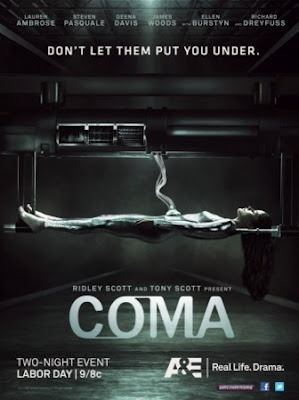
I've never seen the original version of "Coma" (though, like many movies of that era that I haven't seen, I did read the MAD parody -- "Coma-Toast," issue 202, Oct. 1978) so I can't compare, but it had to be better than this mess of a two-part TV movie. During its entire four-hour (!) run, all I could think of was all the good horror movies its cast had been in -- James Woods ("Videodrome"), Ellen Burstyn ("The Exorcist"), Geena Davis ("The Fly") and Richard Dreyfuss ("Jaws.") Normally, in fact, I wouldn't even include a TV movie on this monthly list, but if I had to suffer through four hours (again -- !) of this dreck, it's damn well going to count for something.
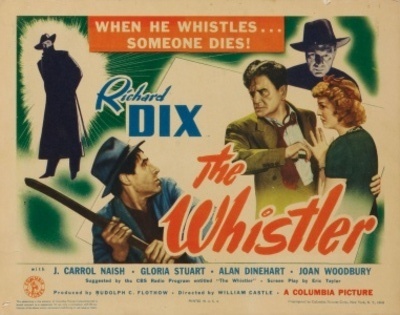
Turner Classic Movies was running the "Whistler" films in September, and I've always had a soft spot for this run of B-movies. Based on a radio series, they all starred Richard Dix, but he played a different character in each, and the only thing that tied them together was the half-assed narration by "The Whistler," who showed up about every 15 minutes or so, said something ominous and whistled a few bars. I've been a fan of Dix ever since I saw him playing the insane captain in Val Lewton's underrated "Ghost Ship," and he's a lot of fun in these films, usually playing a desperate guy with murder on his mind and a bit of lust in his heart. As a bonus, these B-movies top off at about an hour apiece, meaning you can easily fit them into any viewing schedule.
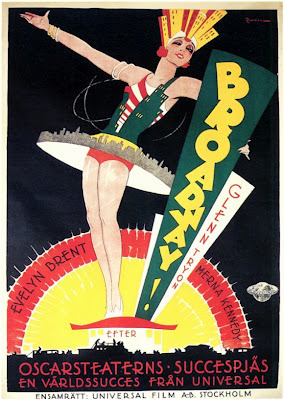
Now here's a real relic, Universal's first talking picture. Not only does it sport (awkward and intermittent) sound, but it even has some color-tinted sequences. The story's not much, a so-so mix of backstage shenanigans and lukewarm gangster antics that feels like they were dated even back in 1929, but the look is occasionally amazing, from the indescribable opening where -- for absolutely no reason -- a giant stalks the street of Broadway (a beautiful miniature) to the nightclub set itself, which was reportedly more than 100 yards long and seven stories high. If you're curious to see it, the entire film is one of the bonus features on Criterion's excellent DVD/Blu-ray of "Lonesome," another movie directed by Paul Fejos.
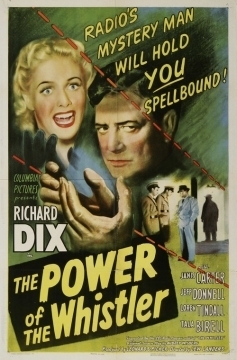
Another Saturday, another "Whistler" movie on TCM. In this one, Dix plays an amnesiac who happens to be a murderer, then happens to get involved with a woman who (sort of) told his fortune with a deck of cards. It doesn't make a whole lot of sense, but Dix (as usual) is fun in his distinctly mopey manner, and even the fake sets and streets are very evocative of 1945 in a low-budget way. I'm not saying I'd want to live there, but I'd sure like to visit.
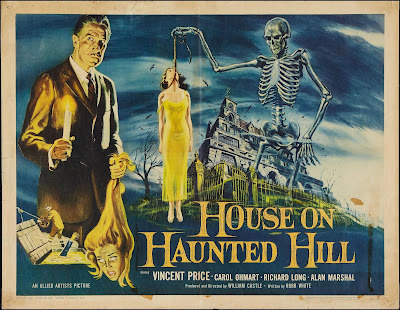
My wife Amy and I decided to delve into producer/William Castle's filmography after getting a kick out of "The Tingler," "Homicidal" and "Straitjacket" (all of which are included on the highly recommended DVD set, "The William Castle Film Collection" -- seriously, it's great!). "House on Haunted Hill" lacks the invigorating craziness of those films, but it's still a lot of fun, with Vincent Price inviting a group of characters to spend the night in -- what else? -- a haunted house. Castle's movies combine clean-cut production with just enough mid-budget charm to win me over every time. (Well, almost every time. Wait until we get to the last movie on this month's list.)
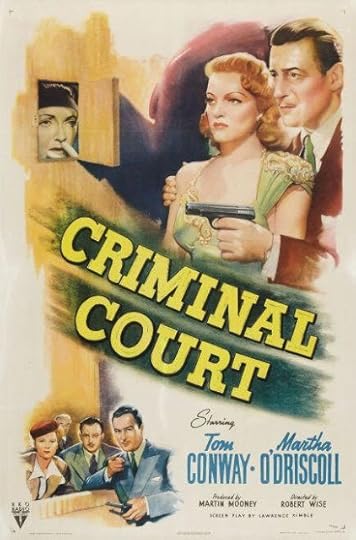
More forgotten film fun from Turner Classic Movies, with Tom Conway (of "Cat People" and "The Seventh Victim" fame) playing a slick attorney who accidentally kills a gangster, then finds his own girlfriend accused of the crime. It's no great shakes, but Conway plays his role to the hilt and Robert Armstrong -- 13 years after "King Kong" -- is solid as the gangster.
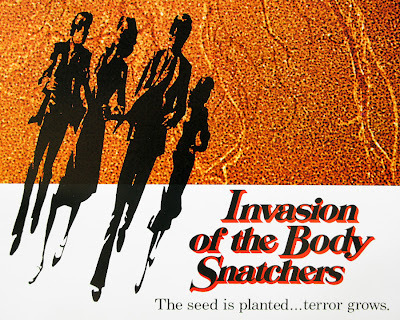
I'd never seen Philip Kaufman's 1978 take on the 1956 paranoia classic, and I was amazed at how good it is -- arguably better than the original. Donald Sutherland, Brooke Adams, Jeff Goldblum and Veronica Cartwright slowly realize that everyone in San Francisco is being replaced by soulless, lookalike pod people, and there's not a whole hell of a lot they can do about it. There's a real sense of menace to Kaufman's film, and you know things aren't going to turn out well. Even the cameo from Kevin McCarthy (screaming "They're here!," just like in the original) isn't so much an in-joke as an early warning that very bad things are on the horizon.
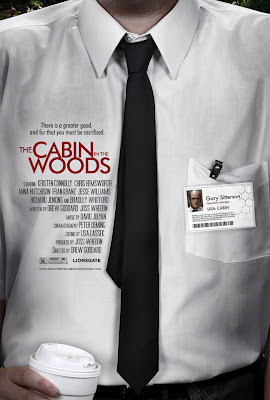
I'm not going to say anything about this one because I don't want to spoil the fun. Heck, even the poster above might give something away, though I don't think it even hints at the horror geek thrills awaiting you inside this loving tribute to monster movies. Just watch it. Trust me.
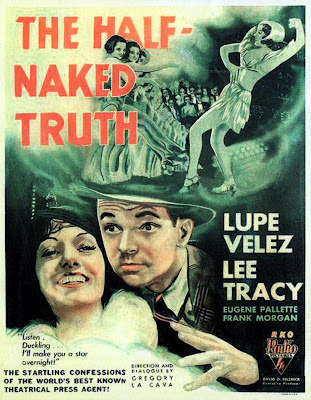
As I've said before in this space, I'm a sucker for pre-Code movies starring fast-talker par excellence Lee Tracy. This one doesn't hit the high notes of "Dr. X" or "Blessed Event," but it's enjoyable watching Tracy play a long con involving Lupe Velez as a foreign princess and Eugene Pallette (surprisingly svelte) as her aide.
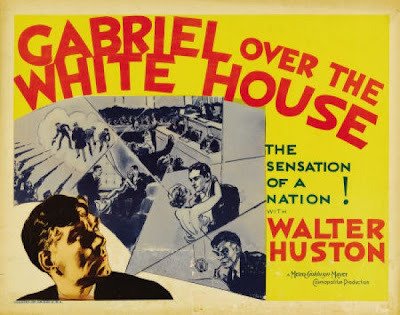
One of my all-time favorites -- and one of the oddest movies ever to slip out of Hollywood. Walter Huston plays a carefree, careless president (he uses the pen Lincoln used to free the slaves to sign sewer legislation) who gets in a car wreck, has some sort of vaguely defined heavenly visitation and becomes the greatest well-meaning fascist ever to dwell at 1600 Pennsylvania Avenue! He executes gangsters, drafts the unemployed and threatens the other nations of the world with destruction if they don't pay their debts and sign his treaty. Crazy stuff -- and perfect for an election year.
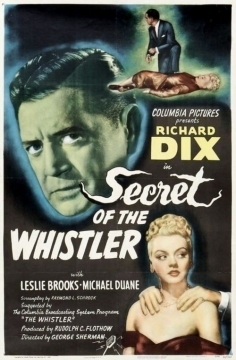
I promise, it's the last "Whistler" movie of the month. Once again, Dix plays a lazy sort of homicidal maniac, this one slowly killing his wife to get her money while painting odd abstracts and trying to romance a semi-attractive blonde. Even I'm not sure how the ending of this one worked itself out, but I know it had something to do with his ex-wife's oddly specific diary (she labeled listings by the TIME they were written) and the most obvious poisoning scheme ever concocted. Heck, until those final credits rolled, I thought the wife had faked her own death. Not so, film fans. Not so.
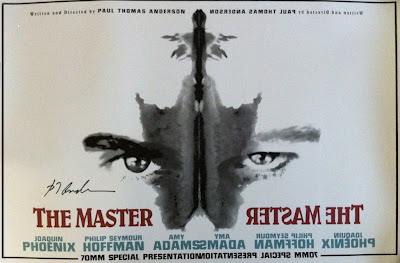
So glad Paul Thomas Anderson's latest made it to the hinterlands of Rockford. I'm a big fan of the guy, and it's a real pleasure to see a complicated film that challenges its audience. Just like Daniel Day Lewis in Anderson's last film, "There Will Be Blood," Joaquin Phoenix gives a shattering performance for the ages, managing to completely live in the skin of a character who, ironically, never seems comfortable in his own skin. Philip Seymour Hoffman is nearly as good, bringing loads of charisma (and just the right touch of angry energy) to his role of a mid-20th century cult leader who is not L. Ron Hubbard. Full of beautiful and beautifully tense senses that perfectly evoke the postwar era (those department store sequences were breathtaking), it's the sort of movie I want to see again. One warning: Your mileage may vary. My wife, Amy, thought the performances were great, but as she said, "It's very sloooooooooooow." Me? I call it "deliberate," and I love it.
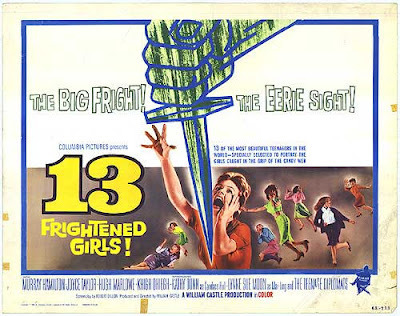
And, unfortunately, instead of ending the month on a bang ("The Master,") I end it on a whimper with a viewing of "13 Frightened Girls!," a deadly dull William Castle snoozefest. See the poster? Seems to promise at least mild excitement in a some sort of horror vein, doesn't it? Well, it lies. The plot actually involves the daughter of a diplomat (Candace "Candy" Hull) who gets involved in international intrigue. Those "Girls" in the title are the other diplomat daughters, and they never seem frightened at all -- mostly because the entire plot is so mild. About the only entertaining thing is watching secret agent Murray Hamilton (you know, the mayor in "Jaws") fend off the advances of 16-year-old Candy. Trivia note: Khigh Dhiegh, who plays the Kang, the Chinese diplomat, made this a year after starring in the brilliant "The Manchurian Candidate."


I've never seen the original version of "Coma" (though, like many movies of that era that I haven't seen, I did read the MAD parody -- "Coma-Toast," issue 202, Oct. 1978) so I can't compare, but it had to be better than this mess of a two-part TV movie. During its entire four-hour (!) run, all I could think of was all the good horror movies its cast had been in -- James Woods ("Videodrome"), Ellen Burstyn ("The Exorcist"), Geena Davis ("The Fly") and Richard Dreyfuss ("Jaws.") Normally, in fact, I wouldn't even include a TV movie on this monthly list, but if I had to suffer through four hours (again -- !) of this dreck, it's damn well going to count for something.

Turner Classic Movies was running the "Whistler" films in September, and I've always had a soft spot for this run of B-movies. Based on a radio series, they all starred Richard Dix, but he played a different character in each, and the only thing that tied them together was the half-assed narration by "The Whistler," who showed up about every 15 minutes or so, said something ominous and whistled a few bars. I've been a fan of Dix ever since I saw him playing the insane captain in Val Lewton's underrated "Ghost Ship," and he's a lot of fun in these films, usually playing a desperate guy with murder on his mind and a bit of lust in his heart. As a bonus, these B-movies top off at about an hour apiece, meaning you can easily fit them into any viewing schedule.

Now here's a real relic, Universal's first talking picture. Not only does it sport (awkward and intermittent) sound, but it even has some color-tinted sequences. The story's not much, a so-so mix of backstage shenanigans and lukewarm gangster antics that feels like they were dated even back in 1929, but the look is occasionally amazing, from the indescribable opening where -- for absolutely no reason -- a giant stalks the street of Broadway (a beautiful miniature) to the nightclub set itself, which was reportedly more than 100 yards long and seven stories high. If you're curious to see it, the entire film is one of the bonus features on Criterion's excellent DVD/Blu-ray of "Lonesome," another movie directed by Paul Fejos.

Another Saturday, another "Whistler" movie on TCM. In this one, Dix plays an amnesiac who happens to be a murderer, then happens to get involved with a woman who (sort of) told his fortune with a deck of cards. It doesn't make a whole lot of sense, but Dix (as usual) is fun in his distinctly mopey manner, and even the fake sets and streets are very evocative of 1945 in a low-budget way. I'm not saying I'd want to live there, but I'd sure like to visit.

My wife Amy and I decided to delve into producer/William Castle's filmography after getting a kick out of "The Tingler," "Homicidal" and "Straitjacket" (all of which are included on the highly recommended DVD set, "The William Castle Film Collection" -- seriously, it's great!). "House on Haunted Hill" lacks the invigorating craziness of those films, but it's still a lot of fun, with Vincent Price inviting a group of characters to spend the night in -- what else? -- a haunted house. Castle's movies combine clean-cut production with just enough mid-budget charm to win me over every time. (Well, almost every time. Wait until we get to the last movie on this month's list.)

More forgotten film fun from Turner Classic Movies, with Tom Conway (of "Cat People" and "The Seventh Victim" fame) playing a slick attorney who accidentally kills a gangster, then finds his own girlfriend accused of the crime. It's no great shakes, but Conway plays his role to the hilt and Robert Armstrong -- 13 years after "King Kong" -- is solid as the gangster.

I'd never seen Philip Kaufman's 1978 take on the 1956 paranoia classic, and I was amazed at how good it is -- arguably better than the original. Donald Sutherland, Brooke Adams, Jeff Goldblum and Veronica Cartwright slowly realize that everyone in San Francisco is being replaced by soulless, lookalike pod people, and there's not a whole hell of a lot they can do about it. There's a real sense of menace to Kaufman's film, and you know things aren't going to turn out well. Even the cameo from Kevin McCarthy (screaming "They're here!," just like in the original) isn't so much an in-joke as an early warning that very bad things are on the horizon.

I'm not going to say anything about this one because I don't want to spoil the fun. Heck, even the poster above might give something away, though I don't think it even hints at the horror geek thrills awaiting you inside this loving tribute to monster movies. Just watch it. Trust me.

As I've said before in this space, I'm a sucker for pre-Code movies starring fast-talker par excellence Lee Tracy. This one doesn't hit the high notes of "Dr. X" or "Blessed Event," but it's enjoyable watching Tracy play a long con involving Lupe Velez as a foreign princess and Eugene Pallette (surprisingly svelte) as her aide.

One of my all-time favorites -- and one of the oddest movies ever to slip out of Hollywood. Walter Huston plays a carefree, careless president (he uses the pen Lincoln used to free the slaves to sign sewer legislation) who gets in a car wreck, has some sort of vaguely defined heavenly visitation and becomes the greatest well-meaning fascist ever to dwell at 1600 Pennsylvania Avenue! He executes gangsters, drafts the unemployed and threatens the other nations of the world with destruction if they don't pay their debts and sign his treaty. Crazy stuff -- and perfect for an election year.

I promise, it's the last "Whistler" movie of the month. Once again, Dix plays a lazy sort of homicidal maniac, this one slowly killing his wife to get her money while painting odd abstracts and trying to romance a semi-attractive blonde. Even I'm not sure how the ending of this one worked itself out, but I know it had something to do with his ex-wife's oddly specific diary (she labeled listings by the TIME they were written) and the most obvious poisoning scheme ever concocted. Heck, until those final credits rolled, I thought the wife had faked her own death. Not so, film fans. Not so.

So glad Paul Thomas Anderson's latest made it to the hinterlands of Rockford. I'm a big fan of the guy, and it's a real pleasure to see a complicated film that challenges its audience. Just like Daniel Day Lewis in Anderson's last film, "There Will Be Blood," Joaquin Phoenix gives a shattering performance for the ages, managing to completely live in the skin of a character who, ironically, never seems comfortable in his own skin. Philip Seymour Hoffman is nearly as good, bringing loads of charisma (and just the right touch of angry energy) to his role of a mid-20th century cult leader who is not L. Ron Hubbard. Full of beautiful and beautifully tense senses that perfectly evoke the postwar era (those department store sequences were breathtaking), it's the sort of movie I want to see again. One warning: Your mileage may vary. My wife, Amy, thought the performances were great, but as she said, "It's very sloooooooooooow." Me? I call it "deliberate," and I love it.

And, unfortunately, instead of ending the month on a bang ("The Master,") I end it on a whimper with a viewing of "13 Frightened Girls!," a deadly dull William Castle snoozefest. See the poster? Seems to promise at least mild excitement in a some sort of horror vein, doesn't it? Well, it lies. The plot actually involves the daughter of a diplomat (Candace "Candy" Hull) who gets involved in international intrigue. Those "Girls" in the title are the other diplomat daughters, and they never seem frightened at all -- mostly because the entire plot is so mild. About the only entertaining thing is watching secret agent Murray Hamilton (you know, the mayor in "Jaws") fend off the advances of 16-year-old Candy. Trivia note: Khigh Dhiegh, who plays the Kang, the Chinese diplomat, made this a year after starring in the brilliant "The Manchurian Candidate."
Published on October 02, 2012 18:42
October 1, 2012
Great Moments in Comics History, Part 2
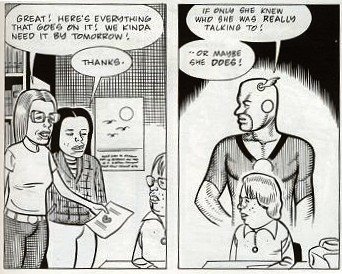
Young Dan Pussey impresses the ladies.
Eightball #12, Nov. 1993; script, pencils, inks and lettering by Dan Clowes
Published on October 01, 2012 20:43
September 29, 2012
Great Moments in Comics History, Part 1
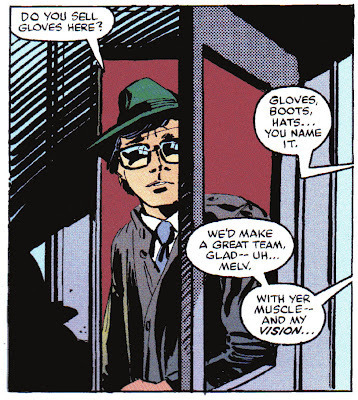
Stilt-Man shops for a glove.
Daredevil #186, Sept. 1986; script and layouts by Frank Miller, finished art and colors by Klaus Janson, letters by Joe Rosen
Published on September 29, 2012 10:11
September 27, 2012
RIP, Herbert Lom
Actor Herbert Lom died Thursday at the age of 95. Though he starred in hundreds of movies including, among many others, Stanley Kubrick's "Spartacus" and the Ealing classic "The Ladykillers," Lom was -- of course -- best known for playing the long suffering (in every sense of the word) Chief Inspector Dreyfus in the Pink Panther movies, acting as the perfect foil to Peter Seller's Inspector Clouseau.
I mean, I'm a film fan who respects a long, varied career of someone like Lom, but that's how I'm going to remember him -- because he was very, very good in the role. Against all odds, in the scenes he shared with Sellers, Lom somehow managed to be the funniest guy onscreen.
Here's a scene he played alone, though the spirit of Clouseau definitely hangs over the moment. Clouseau is thought to be dead (spoiler alert -- he's not), and Dreyfus has to deliver his eulogy. (Skip to about the one minute mark.) It's from "Revenge of the Pink Panther," which is far from the best in the series, but Lom's performance as a man trying not to laugh at a very serious moment is top notch.

I mean, I'm a film fan who respects a long, varied career of someone like Lom, but that's how I'm going to remember him -- because he was very, very good in the role. Against all odds, in the scenes he shared with Sellers, Lom somehow managed to be the funniest guy onscreen.
Here's a scene he played alone, though the spirit of Clouseau definitely hangs over the moment. Clouseau is thought to be dead (spoiler alert -- he's not), and Dreyfus has to deliver his eulogy. (Skip to about the one minute mark.) It's from "Revenge of the Pink Panther," which is far from the best in the series, but Lom's performance as a man trying not to laugh at a very serious moment is top notch.
Published on September 27, 2012 18:26
September 25, 2012
While you're visiting 2004, be sure to visit scenic Sub Diego
Special thanks to Jay Faerber, who included Aquaman issues 16 to 22 in his "Three Underrated Comic Book Runs" article in the brand-new book, "Why Does Batman Carry Shark Repellent?" ($15, Plume) by Brian Cronin.
Here's the cover of the book...
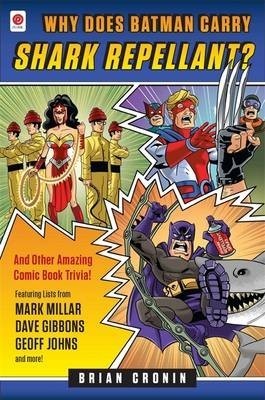
And here's what Jay had to say about that run on Aquaman...
"Writer Will Pfeifer and penciller Patrick Gleason took over Aquaman in 2004 and launched the series into a great, short-lived direction: part of the city of San Diego was submerged after an earthquake and all of its inhabitants somehow gained the ability to breathe underwater, with Aquaman reigning. The idea of an underwater city full of people who were struggling to adjust to their new lot in life was one that was rife with potential, and Pfeifer made great use of it."
And here, as a bonus, is a photo from spring's C2E2 convention in Chicago featuring a reunion of the team that brought you those issues of Aquaman. From left, yours truly, penciller Patrick Gleason and inker Christian Alamy. And yes, that photo was taken in a bar. Why do you ask?
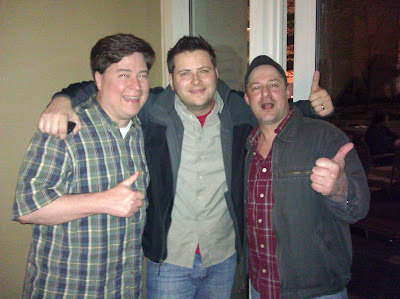

Here's the cover of the book...

And here's what Jay had to say about that run on Aquaman...
"Writer Will Pfeifer and penciller Patrick Gleason took over Aquaman in 2004 and launched the series into a great, short-lived direction: part of the city of San Diego was submerged after an earthquake and all of its inhabitants somehow gained the ability to breathe underwater, with Aquaman reigning. The idea of an underwater city full of people who were struggling to adjust to their new lot in life was one that was rife with potential, and Pfeifer made great use of it."
And here, as a bonus, is a photo from spring's C2E2 convention in Chicago featuring a reunion of the team that brought you those issues of Aquaman. From left, yours truly, penciller Patrick Gleason and inker Christian Alamy. And yes, that photo was taken in a bar. Why do you ask?

Published on September 25, 2012 17:55
Will Pfeifer's Blog
- Will Pfeifer's profile
- 23 followers
Will Pfeifer isn't a Goodreads Author
(yet),
but they
do have a blog,
so here are some recent posts imported from
their feed.



